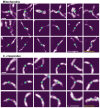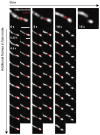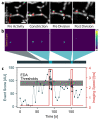Event-driven acquisition for content-enriched microscopy
- PMID: 36076039
- PMCID: PMC7613693
- DOI: 10.1038/s41592-022-01589-x
Event-driven acquisition for content-enriched microscopy
Abstract
A common goal of fluorescence microscopy is to collect data on specific biological events. Yet, the event-specific content that can be collected from a sample is limited, especially for rare or stochastic processes. This is due in part to photobleaching and phototoxicity, which constrain imaging speed and duration. We developed an event-driven acquisition framework, in which neural-network-based recognition of specific biological events triggers real-time control in an instant structured illumination microscope. Our setup adapts acquisitions on-the-fly by switching between a slow imaging rate while detecting the onset of events, and a fast imaging rate during their progression. Thus, we capture mitochondrial and bacterial divisions at imaging rates that match their dynamic timescales, while extending overall imaging durations. Because event-driven acquisition allows the microscope to respond specifically to complex biological events, it acquires data enriched in relevant content.
© 2022. The Author(s), under exclusive licence to Springer Nature America, Inc.
Conflict of interest statement
The authors declare that they have no conflict of interest.
Figures








References
-
- Laissue PP, Alghamdi RA, Tomancak P, Reynaud EG, Shroff H. Assessing Phototoxicity in Live Fluorescence Imaging. Nat Methods. 2017 July;14:657–661. ISSN: 1548-7091, 1548-7105. - PubMed
-
- Scherf N, Huisken J. The Smart and Gentle Microscope. Nat Biotechnol. 2015 Aug;33:815–818. ISSN: 1087-0156, 1546-1696. - PubMed
-
- Grimm JB, Lavis LD. Caveat Fluorophore: An Insiders’ Guide to Small-Molecule Fluorescent Labels. Nat Methods. 2022 Feb;19:149–158. ISSN: 1548-7091, 1548-7105. - PubMed
-
- Weigert M, et al. Content-Aware Image Restoration: Pushing the Limits of Fluorescence Microscopy. Nat Methods. 2018 Dec;15:1090–1097. ISSN: 1548-7105. - PubMed
Publication types
MeSH terms
Grants and funding
LinkOut - more resources
Full Text Sources
Research Materials

